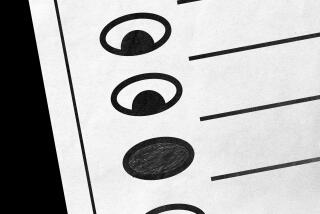Long road to a convention
The first barrier to Californians calling a convention to draft a new state Constitution: Doing so may be unconstitutional.
The current document, adopted in 1879 and amended hundreds of times since, protects itself by outlining the single way it can be scrapped. Voters can call a convention, but only after two-thirds of the members of each house of the Legislature put the question on the ballot. Two lawmakers introduced bills late last year to call for a convention, but they are unlikely to get anywhere because many members of the Legislature correctly see in the move a wrenching change in the way they currently do business.
Voters can amend the Constitution, but only a piece at a time because of yet another provision known as the âsingle subject rule.â They can limit the terms of elected officials, for example, but they canât adopt a package that deals simultaneously with term limits, redistricting, political contributions, the vote threshold for adopting a budget and raising taxes, and a spending cap. But special interests that might accept comprehensive reform, in which each provision balances the others, tend to defeat piecemeal initiatives.
So if the Legislature holds the sole key to a convention, are Californians stuck? No. Repair California, the coalition now pushing for a convention in 2012, has mapped a way forward. It requires several steps.
First up is an initiative -- to amend the Constitution to allow the people to call a convention without the Legislature. Repair California is aiming for the November 2010 ballot, when voters elect a new governor to replace Arnold Schwarzenegger. That election is right around the corner, and the secretary of state is recommending Sept. 25 as a target date to file applications with the attorney general for the required ballot title and summary.
The attorney general has until Nov. 17 to return the title and summary, and then Repair California has 150 days to gather nearly 700,000 valid signatures.
There would have to be a parallel âProposition 2â to actually call the convention. The same title, summary, signature and deadline rules apply.
Our prediction: These measures would find a receptive public. Voters baffled and dismayed by Sacramentoâs paralysis are ready for a new approach.
The scope of the convention could be limited in the measures. Some proponents want everything on the table, from a reconsideration of last yearâs Proposition 8 marriage restriction to Proposition 13 to pretty much anything else. The approach carries some appeal; whatâs the point, after all, of a citizensâ convention if citizens are limited in what they can do? But including subjects as diverse and as divisive as taxes and marriage rights invites the same kind of emotional turmoil that has plagued the initiative process and has gummed up the Constitution.
Repair California has not finalized its plan, but it has been promoting a limited agenda that includes only four broad topics: governance, including how the Legislature and state agencies and commissions are structured and operate; elections, including initiatives, campaign finance and term limits; the budget, including the threshold (two-thirds, simple majority, or something else) for the Legislature to adopt a budget, plus spending limits and requirements; and revenue distribution, especially how tax money is allocated among state and local governments.
The thorniest question, which also must be decided next month to make next yearâs general election ballot, is who will be the delegates. Countless efforts at redistricting commissions have crashed and burned because various interests could not agree on how to pick members. Do you want democracy? Elect the members. But then delegate selection becomes mired in the same political partisanship, the same special- interest string-pulling and commitment-extracting that a convention is, in part, intended to curtail. Do you want to avoid all that? Appoint the delegates. But who does the appointing? The same problems arise: The powers of the status quo, and the special interests, insert their hand into the process.
Repair California is also studying a citizens assembly approach, modeled on a Canadian system, in which citizens are summoned, perhaps from each county or Assembly district, using voter rolls. Up to 200 people would meet, confer and then pick perhaps three people from among them to be convention delegates. They would be paid for their time, perhaps an amount equal to what Assembly members get paid.
Other ideas are worth considering and blending: County boards of supervisors could nominate some delegates, state officials could name others, some could secure positions by election. No method is perfect. The question of how best to select delegates is vital, and weâll explore it more fully in forthcoming editorials.
Repair California expects a convention process to move at a fairly fast clip for such a large job. Californians would vote next year to convene a convention, it would meet over the next 12 to 18 months, and the final product would go on the ballot in 2012.
Some critics say thatâs too long to wait; we need reform now to address severe problems with our budget process, our prisons, our infrastructure, our confidence in government. That may be so, but government has failed so far to make the necessary reforms, and there is little prospect of it doing so any time soon. Fixing California can proceed on multiple tracks. Efforts in the Legislature, or at the ballot box, are welcome. But plans for a convention should go forward to give lawmakers some sense of urgency, and to allow Californians to take charge of their own destiny should their representatives, once again, fall short.
--
For other editorials in this series, go to http://ukobiw.net./CaliforniaFix.
More to Read
Get the L.A. Times Politics newsletter
Deeply reported insights into legislation, politics and policy from Sacramento, Washington and beyond. In your inbox three times per week.
You may occasionally receive promotional content from the Los Angeles Times.










